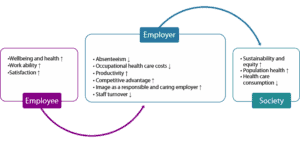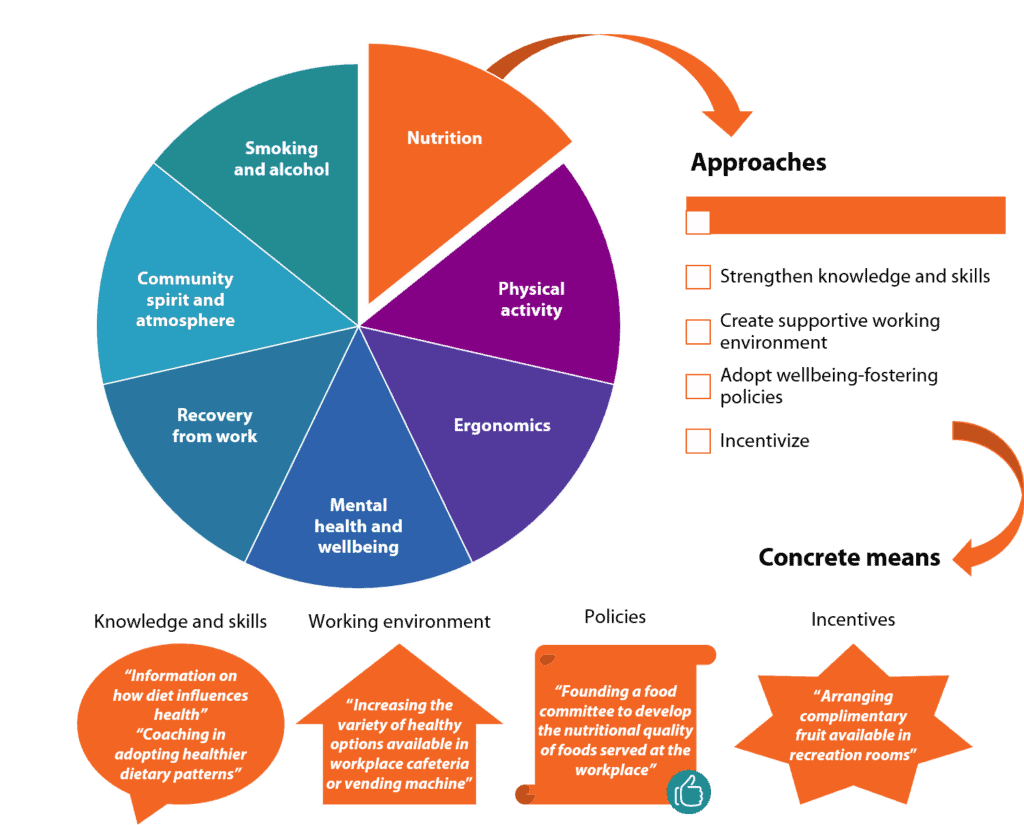Estimated reading time: 6 minutes
More than one in four European employees suffer from a long-standing illness or health condition [1], and an even larger proportion is at risk of developing health problems in the future. These issues threaten to increase absenteeism and healthcare costs, and to limit employees’ ability to perform their daily tasks. The solution is to adopt a proactive stance and take measures that foster the wellbeing and health of employees. As a result of a pan-European collaboration, workplaces now have the tools they need to succeed thanks to a free toolkit for workplaces for employee health, wellbeing, and participation.
by Eeva Rantala, Jaana Lindström and Lina Papartyte
Wellbeing at work is everybody’s business
Many chronic health conditions have their origin in the way we live, and the way we live is shaped by the environments we inhabit. Most adults spend a substantial proportion of waking hours at work – so workplaces are an excellent setting to reach large groups of people and promote health. Fostering staff wellness benefits employees, employers, and wider societies in many ways [2][3][4]

Employers and employees have a shared responsibility for staff wellness. Employees should take care of themselves by making choices and acting in ways that support personal health and their ability to work. Employers, in turn, can be seen as enablers. They have the responsibility to encourage and provide guidance for employees, and create workplaces and working conditions that facilitate the adoption and maintenance of healthy lives and working patterns. Together, employers and employees should seek solutions that enable employees to keep working and to reach their highest potential for good health, whatever their situation.
120 ways to promote employees’ wellness
The Finnish Institute for Health and Welfare (THL) and 16 partner organisations from 11 EU member states developed the CHRODIS PLUS Toolkit for Workplaces for fostering employees health, wellbeing, and participation, building on scientific evidence and experiences in the field. The toolkit is part of the CHRODIS PLUS Workbox on Employment and Chronic Conditions, which also contains a Training Tool for Managers. This tool promotes the inclusion, integration, work ability, and return to work of employees with chronic conditions. The workbox was developed within the EU-funded Joint Action CHRODIS PLUS (2017−2020).
What’s inside the toolkit
The Toolkit for workplaces comprises 127 concrete ways to foster the wellbeing, health, and work participation of all employees, regardless of their current work ability and health status. This includes ways to prevent the development and aggravation of chronic health problems, such as cardiovascular diseases, type 2 diabetes, musculoskeletal disorders, depression, and lung diseases.
Seven domains are covered by the toolkit for workplaces:


- nutrition
- Physical activity.
- Ergonomics.
- Mental health and wellbeing.
- Recovery from work.
- Community spirit and atmosphere.
- Smoking cessation and reduction of excess alcohol consumption.
Within each domain, the means are further grouped into four approaches:
- Knowledge and skills
- Working environment
- Organisational policies
- Incentives
Besides the domains, approaches, and means, the Toolkit for employee health, wellbeing, and participation also has three useful appendixes:
- A checklist for mapping out the baseline situation at the workplace and for selecting relevant means for implementation.
- A guide to designing a successful implementation of selected means.
- A model for identifying and finding solutions to employees’ potential health problems early on.
One empoyee health toolkit for many workplaces and different needs
There are many different types of workplaces, with different needs and capabilities to act and change. For that reason, the Toolkit for employee health, wellbeing, and participation aims to help all workplaces identify what is most relevant for them.
Within the CHRODIS PLUS project, ten workplaces from six European countries reviewed and piloted the Toolkit. They all found areas for action, and said it was useful and well-constructed, suggesting that the toolkit is indeed adaptable to diverse workplaces and for independent use [5].
Organisations with small and tight budgets can also use the toolkit, as many measures can be introduced with limited resources. Even small measures can substantially influence employee wellbeing, job satisfaction, and commitment to work. In this game, everything counts.
We recommend the Toolkit for all actors involved in promoting occupational wellbeing and health, including managers, human resources, occupational healthcare, catering services, and policymakers.
Healthy workplaces can help businesses and employees recover from the pandemic
In the post-COVID world, focusing on the wellness of the workforce will be more important than ever. The pandemic has challenged both mental and physical health. Healthy lifestyles and working patterns strengthen our resilience and resistance not only to chronic noncommunicable illnesses but to infectious diseases as well.
Employers can redesign work and work environments so that making healthy choices throughout the workday becomes effortless, intuitive, socially approved, and attractive for all employees. When repeated, small healthy actions turn into habits, and habits adopted at the workplace can spill over to leisure time too. Thus, workplaces can assist their staff—and consequently their businesses—to come out of the crisis stronger than they were before.
More information on the CHRODIS PLUS Toolkit for Workplaces:
An introduction to the toolkit for workplaces for employee health and wellbeing
This video is also available in Dutch – Hungarian – Finnish – French
References
[1] Eurostat Statistics Explained 2020. Self-perceived health statistics. https://ec.europa.eu/eurostat/statistics-explained/index.php?title=Self-perceived_health_statistics. Accessed 7 August 2021.
[2] Grimani A, Aboagye E, Kwak L. The effectiveness of workplace nutrition and physical activity interventions in improving productivity, work performance and work ability: a systematic review. BMC Public Health 2019;19:1676. https://doi.org/10.1186/s12889-019-8033-1
[3] Krekel C, Ward G, De Neve J-E. Employee Wellbeing, Productivity, and Firm Performance (March 3, 2019). Saïd Business School WP 2019-04. http://dx.doi.org/10.2139/ssrn.3356581
[4] WHO & World Economic Forum. Preventing noncommunicable diseases in the workplace through diet and physical activity: WHO/World Economic Forum report of a joint event. Geneva: World Health Organization / World Economic Forum 2008. https://apps.who.int/iris/handle/10665/43825.
[5] Rantala E, Lindström J. D8.2. Toolkit for workplaces to promote health, prevent chronic health problems, and foster work participation of individuals with chronic diseases: Deliverable 8.2 of the EU Joint Action CHRODIS PLUS 2017−2020. European Commission EC: September 2020. http://chrodis.eu/wp-content/uploads/2021/01/chrodis-plus-d8.2-toolkit-for-workplaces-1.pdf




